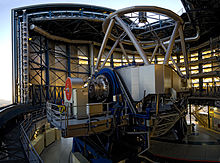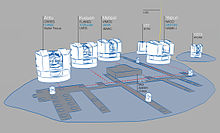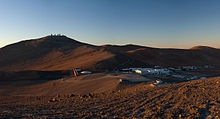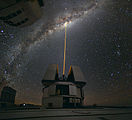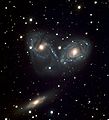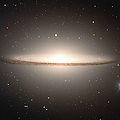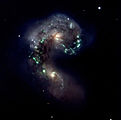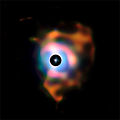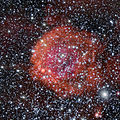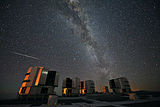- Very Large Telescope
-
Very Large Telescope 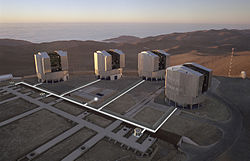 The four Unit Telescopes that form the VLT together with the Auxiliary Telescopes
The four Unit Telescopes that form the VLT together with the Auxiliary TelescopesOrganization European Southern Observatory (ESO) Location Paranal Observatory, Atacama desert, Chile Coordinates 24°37′38″S 70°24′15″W / 24.62722°S 70.40417°W Altitude 2,635 m Weather >340 clear nights/year Wavelength 300 nm – 20 μm (optical, near- and mid-infrared) First light 1998 (for the first Unit Telescope) Telescope style Ritchey-Chrétien Diameter 4 x 8.2-metre Unit Telescopes (UT), plus 4 x 1.8-metre moveable Auxiliary Telescopes (AT) Mounting Altazimuth Website Very Large Telescope The Very Large Telescope (VLT) is a telescope operated by the European Southern Observatory on Cerro Paranal in the Atacama Desert of northern Chile. The VLT consists of four individual telescopes, each with a primary mirror 8.2m across, which are generally used separately but can be used together to achieve very high spatial resolution.[1] The four separate optical telescopes are known as Antu, Kueyen, Melipal and Yepun, which are all words for astronomical objects in the Mapuche language. The telescopes form an array which is complemented by four movable Auxiliary Telescopes (ATs) of 1.8 m aperture.
The VLT operates at visible and infrared wavelengths. Each individual telescope can detect objects roughly four billion times fainter than what can be detected with the naked eye, and when all the telescopes are combined, the facility can achieve an angular resolution of about 0.001 arc-second. This is equivalent to roughly two metres at the distance of the Moon.[1]
The VLT is the most productive ground-based facility for astronomy, with only the Hubble Space Telescope generating more scientific papers among facilities operating at visible wavelengths.[2] Among the pioneering observations carried out using the VLT are the first direct image of an exoplanet, the tracking of individual stars moving around the supermassive black hole at the centre of the Milky Way, and observations of the afterglow of the furthest known gamma-ray burst.[3]
Contents
General information
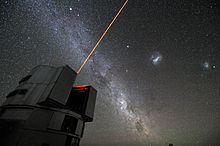 A laser that is used for adaptive optics (excites sodium atoms in atmosphere and creates an artificial star)
A laser that is used for adaptive optics (excites sodium atoms in atmosphere and creates an artificial star)
The VLT consists of an arrangement of four large (8.2 meter diameter) telescopes with optical elements that can combine them into an astronomical interferometer (VLTI), which is used to resolve small objects. The interferometer also includes a set of four 1.8 meter diameter movable telescopes dedicated to interferometric observations. The first of the UTs started operating in May 1998 and was offered to the astronomical community on 1 April 1999. The other telescopes followed suit in 1999 and 2000, thus making the VLT fully operational. Four 1.8-metre Auxiliary Telescopes (ATs) have been added to the VLTI to make it available when the UTs are being used for other projects. These ATs were installed between 2004 and 2007. Today, all four Unit Telescopes and all four Auxiliary Telescopes are operational.[1]
The VLT's 8.2-meter telescopes were originally designed to operate in three modes:[4]
- as a set of four independent telescopes (this is the primary mode of operation).
- as a single large coherent interferometric instrument (the VLT Interferometer or VLTI), for extra resolution. This mode is occasionally used, only for observations of relatively bright sources with small angular extent.
- as a single large incoherent instrument, for extra light-gathering capacity. The instrumentation required to bring the light to a combined incoherent focus was not built. Recently, new instrumentation proposals have been put forward for making this observing mode available.[5] Multiple telescopes are sometimes independently pointed at the same object, either to increase the total light-gathering power, or to provide simultaneous observations with complementary instruments.
Unit Telescopes
The UTs are equipped with a large set of instruments permitting observations to be performed from the near-ultraviolet to the mid-infrared (i.e. a large fraction of the light wavelengths accessible from the surface of the Earth), with the full range of techniques including high-resolution spectroscopy, multi-object spectroscopy, imaging, and high-resolution imaging. In particular, the VLT has several adaptive optics systems, which correct for the effects of atmospheric turbulence, providing images almost as sharp as if the telescope were in space. In the near-infrared, the adaptive optics images of the VLT are up to three times sharper than those of the Hubble Space Telescope, and the spectroscopic resolution is many times better than Hubble. The VLTs are noted for their high level of observing efficiency and automation.
The 8.2m-diameter telescopes are housed in compact, thermally controlled buildings, which rotate synchronously with the telescopes. This design minimises any adverse effects on the observing conditions, for instance from air turbulence in the telescope tube, which might otherwise occur due to variations in the temperature and wind flow.[3]
The principal role of the main VLT telescopes is to operate as four independent telescopes. The interferometry (combining light from multiple telescopes) is used about 20 percent of the time for very high-resolution on bright objects, for example, on Betelgeuse. This mode allows astronomers to see details up to 25 times finer than with the individual telescopes. The light beams are combined in the VLTI using a complex system of mirrors in underground tunnels where the light paths must be kept equal to distances less than 1/1000 mm over a hundred metres. With this kind of precision the VLTI can reconstruct images with an angular resolution of milliarcseconds.[1]
Mapuche names for the Unit Telescopes
It had long been ESO's intention to provide "real" names to the four VLT Unit Telescopes, to replace the original, somewhat dry and technical designations of UT1 to UT4. In March 1999, at the time of the Paranal inauguration, four meaningful names of objects in the sky in the Mapuche language were chosen. This indigenous people lives mostly south of Santiago de Chile.
An essay contest was arranged in this connection among schoolchildren of the Chilean II Region of which Antofagasta is the capital to write about the implications of these names. It drew many entries dealing with the cultural heritage of ESO's host country.
The winning essay was submitted by 17-year old Jorssy Albanez Castilla from Chuquicamata near the city of Calama. She received the prize, an amateur telescope, during the Paranal Inauguration.[6]
The four Unit Telescopes are now known as:[7] Antu (UT1; The Sun), Kueyen (UT2; The Moon), Melipal (UT3; The Southern Cross), and Yepun (UT4; Venus—as evening star). Originally translated as "Sirius", it now seems that "Yepun" actually means "Venus".[8]
Auxiliary Telescopes
Although the four 8.2-metre Unit Telescopes can be combined in the VLTI, they are mostly used for individual observations and are only available for interferometric observations for a limited number of nights every year. But the four smaller 1.8-metre ATs are available and dedicated to interferometry to allow the VLTI to operate every night.[3]
The top part of each AT is a round enclosure, made from two sets of three segments, which open and close. Its job is to protect the delicate 1.8-metre telescope from the desert conditions. The enclosure is supported by the boxy transporter section, which also contains electronics cabinets, liquid cooling systems, air-conditioning units, power supplies, and more. During astronomical observations the enclosure and transporter are mechanically isolated from the telescope, to ensure that no vibrations compromise the data collected.[1]
The transporter section runs on tracks, so the ATs can be moved to 30 different observing locations. As the VLTI acts rather like a single telescope as large as the group of telescopes combined, changing the positions of the ATs means that the VLTI can be adjusted according to the needs of the observing project.[1]
Science with the VLT
Results from the VLT have led to the publication of an average of more than one peer-reviewed scientific paper per day. For instance in 2007, almost 500 refereed scientific papers were published based on VLT data.[9] The telescope's scientific discoveries include imaging an extrasolar planet for the first time,[10] tracking individual stars moving around the supermassive black hole at the centre of the Milky Way,[11] and observing the afterglow of the furthest known gamma-ray burst.[12]
Other discoveries with VLT's signature include the detection of carbon monoxide molecules in a galaxy located almost 11 billion light-years away for the first time, a feat that had remained elusive for 25 years. This has allowed astronomers to obtain the most precise measurement of the cosmic temperature at such a remote epoch.[13] Another important study was that of the violent flares from the supermassive black hole at the centre of the Milky Way. The VLT and APEX teamed up to reveal material being stretched out as it orbits in the intense gravity close to the central black hole.[14]
Using the VLT, astronomers have also measured the age of the oldest star known in our galaxy, the Milky Way. At 13.2 billion years old, the star was born in the earliest era of star formation in the Universe.[15] They have also analysed the atmosphere around a super-Earth exoplanet for the first time using the VLT. The planet, which is known as GJ 1214b, was studied as it passed in front of its parent star and some of the starlight passed through the planet’s atmosphere.[16]
In all, of the top 10 discoveries done at ESO's observatories, seven have VLT's signature.[17]
Technical details
Instruments
The VLT instrumentation programme is the most ambitious programme ever conceived for a single observatory. It includes large-field imagers, adaptive optics corrected cameras and spectrographs, as well as high-resolution and multi-object spectrographs and covers a broad spectral region, from deep ultraviolet (300 nm) to mid-infrared (24 µm) wavelengths.[1]
Instruments on the VLT[18][19] Telescope Cassegrain-Focus Nasmyth-Focus A Nasmyth-Focus B Antu (UT1) FORS 2 CRIRES Guest focus Kueyen (UT2) X-Shooter FLAMES UVES Melipal (UT3) VISIR ISAAC VIMOS Yepun (UT4) SINFONI HAWK-I NACO - FORS 1 (FOcal Reducer and low dispersion Spectrograph) is a visible light camera and Multi Object Spectrograph with a 6.8 arcminute field of view.
- FORS 2. Like FORS 1, but with further multi-object spectroscopy.
- ISAAC (Infrared Spectrometer And Array Camera) is a near infrared imager and spectrograph
- UVES (Ultraviolet and Visual Echelle Spectrograph) is an ultraviolet and visible light spectrograph.
- FLAMES (Fibre Large Area Multi-Element Spectrograph) is a multi-object fibre feed unit for UVES and GIRAFFE, the latter allowing the capability for simultaneously studying hundreds of individual stars in nearby galaxies at moderate spectral resolution in the visible.
- NACO (NAOS-CONICA, NAOS meaning Nasmyth Adaptive Optics System and CONICA meaning COude Near Infrared CAmera) is an adaptive optics facility which produces infrared images as sharp as if taken in space and includes spectroscopic, polarimetric and coronagraphic capabilities.
- VISIR (VLT spectrometer and imager for the mid-infrared) provides diffraction-limited imaging and spectroscopy at a range of resolutions in the 10 and 20 micrometre mid-infrared (MIR) atmospheric windows.
- SINFONI (Spectrograph for INtegral Field Observations in the Near Infrared) is a medium resolution, near-infrared (1-2.5 micrometres) integral field spectrograph fed by an adaptive optics module.
- CRIRES (CRyogenic InfraRed Echelle Spectrograph) is adaptive optics assisted and provides a resolving power of up to 100,000 in the infrared spectral range from 1 to 5 micrometres.
- HAWK-I (High Acuity Wide field K-band Imager) is a near-infrared imager with a relatively large field of view.
- VIMOS (VIsible Multi-Object Spectrograph) delivers visible images and spectra of up to 1,000 galaxies at a time in a 14 x 14 arcmin field of view.
- X-Shooter, the first second-generation instrument, a wide-band [UV to near infrared] spectrometer designed to explore the properties of rare, unusual or unidentified sources
- PIONIER, an instrument to combine the light of all 8-metre telescopes, allowing to pick up details about 16 times finer than can be seen with one UT.[20]
- Guest focus available for visitor instruments, such as ULTRACAM or DAZZLE.
Several second-generation VLT instruments are now under development:
- KMOS, a cryogenic infrared multi-object spectrometer intended primarily for the study of distant galaxies.[21]
- MUSE, a huge "3-dimensional" spectroscopic explorer which will provide complete visible spectra of all objects contained in "pencil beams" through the Universe. [22]
- SPHERE, a high-contrast adaptive optics system dedicated to the discovery and study of exoplanets.[23]
- SAXO (SPHERE extreme AO system), an instrument that combines an extreme adaptive optics system, various coronagraphic devices and a suite of focal instruments providing imaging, integral field spectroscopy and polarimetry capabilities in the visible and near-infrared spectral ranges. [24]
- ESPRESSO (Echelle Spectrograph for Rocky Exoplanet- and Stable Spectroscopic Observations), a high-resolution, fiber-fed and cross-dispersed echelle spectrograph for the visible wavelength range, capable of operating in 1-UT mode and in 4-UT mode, for the search for rocky extra-solar planets in the habitable zone of their host stars.[25]
Interferometry and the VLTI
In its interferometric operating mode, the light from the telescopes is reflected off mirrors and directed through tunnels to a central beam combining laboratory. The VLTI is intended to achieve an effective angular resolution of 0.002 arcsecond at a wavelength of 2 µm. This is comparable to the resolution achieved using other arrays such as the Navy Prototype Optical Interferometer and the CHARA array. Unlike many earlier optical and infrared interferometers, the AMBER instrument on VLTI was initially designed to perform coherent integration (which requires signal-to-noise greater than one in each atmospheric coherence time). Using the big telescopes and coherent integration, the faintest object the VLTI can observe is magnitude 7 in the near infrared for broadband observations,[26] similar to many other near infrared / optical interferometers without fringe tracking2. In 2011, an incoherent integration mode was introduced [27] called AMBER "blind mode" which is more similar to the observation mode used at earlier interferometer arrays such as COAST, IOTA and CHARA. In this "blind mode", AMBER can observe sources as faint as K=10 in medium spectral resolution. At more challenging mid-infrared wavelengths, the VLTI can reach magnitude 4.5, significantly fainter than the Infrared Spatial Interferometer. When fringe tracking is introduced, the limiting magnitude of the VLTI is expected to improve by a factor of almost 1000, reaching a magnitude of about 14. This is similar to what is expected for other fringe tracking interferometers. In spectroscopic mode, the VLTI can currently reach a magnitude of 1.5. The VLTI can work in a fully integrated way, so that interferometric observations are actually quite simple to prepare and execute. The VLTI has become worldwide the first general user optical/infrared interferometric facility offered with this kind of service to the astronomical community.[28]
Because of the many mirrors involved in the optical train, about 95 percent of the light is lost before reaching the instruments at a wavelength of 1 µm, 90 percent at 2 µm and 75 percent at 10 µm.[29] This refers to reflection off 32 surfaces including the Coudé train, the star separator, the main delay line, beam compressor and feeding optics. Additionally, the interferometric technique is such that it is very efficient only of objects that are small enough that all their light is concentrated. For instance, an object with a relatively low surface brightness such as the moon cannot be observed, because its light is too diluted. Only targets which are at temperatures of more than 1,000°C have a surface brightness high enough to be observed in the mid-infrared, and objects must be at several thousands of degrees Celsius for near-infrared observations using the VLTI. This includes most of the stars in the solar neighborhood and many extragalactic objects such as bright active galactic nuclei, but this sensitivity limit rules out interferometric observations of most solar-system objects. Although the use of large telescope diameters and adaptive optics correction can improve the sensitivity, this cannot extend the reach of optical interferometry beyond nearby stars and the brightest active galactic nuclei.
Because the Unit Telescopes are used most of the time independently, they are used in the interferometric mode mostly during bright time (that is, close to Full Moon). At other times, interferometry is done using 1.8 meter Auxiliary Telescopes (ATs), which are dedicated to full-time interferometric measurements. The first observations using a pair of ATs were conducted in February 2005, and all the four ATs have now been commissioned. For interferometric observations on the brightest objects, there is little benefit in using 8 meter telescopes rather than 1.8 meter telescopes.
The first two instruments at the VLTI were VINCI (a test instrument used to set-up the system, now decommissioned) and MIDI,[30] which only allow two telescopes to be used at any one time. With the installation of the three-telescope AMBER closure-phase instrument in 2005, the first imaging observations from the VLTI are expected soon. Deployment of The Phase Referenced Imaging and Microarcsecond Astrometry (PRIMA) instrument started 2008 with the aim to allow phase-referenced measurements in either an astrometric two-beam mode or as a fringe-tracker successor to VINCI, operated concurrent with one of the other instruments.[31][32][33]
After falling drastically behind schedule and failing to meet some specifications, in December 2004 the VLT Interferometer became the target of a second ESO "recovery plan". This involves additional effort concentrated on improvements to fringe tracking and the performance of the main delay lines. Note that this only applies to the interferometer and not other instruments on Paranal. In 2005, the VLTI was routinely producing observations, although with a brighter limiting magnitude and poorer observing efficiency than expected.
As of March 2008[update], the VLTI had already led to the publication of 89 peer-reviewed publications[34][35][36] and had published a first-ever image of the inner structure of the mysterious Eta Carinae.[37]. In March 2011, the PIONIER instrument combines simultaneously for the first time the light of the four Unit Telescopes, making VLTI the biggest optical telescope of the world[38].
In popular culture
One of the large mirrors of the telescopes was the subject of an episode of the National Geographic Channel's reality series World's Toughest Fixes, where a crew of engineers removed and transported the mirror to be cleaned and re-coated with aluminium. The job required battling strong winds, fixing a broken pump in a giant washing machine and resolving a rigging issue.
The area surrounding the Very Large Telescope has also been featured in a blockbuster movie. The VLT Hotel, the Residencia, is an award-winning building, and served as a backdrop for part of the James Bond movie Quantum of Solace.[3] The movie producer, Michael G. Wilson, said: “The Residencia of Paranal Observatory caught the attention of our director, Marc Forster and production designer, Dennis Gassner, both for its exceptional design and its remote location in the Atacama desert. It is a true oasis and the perfect hide out for Dominic Greene, our villain, whom 007 is tracking in our new James Bond film.”[39]
Gallery
-

Huge storm on Saturn observed by ESO's Very Large Telescope
See also
References
- ^ a b c d e f g "The Very Large Telescope". ESO. http://www.eso.org/public/teles-instr/vlt.html. Retrieved 2011-08-05.
- ^ http://cdsads.u-strasbg.fr/abs/2010AN....331..338T
- ^ a b c d "The Very Large Telescope — The World’s Most Advanced Visible-light Astronomical Observatory handout". ESO. http://www.eso.org/public/products/brochures/vlt_handout/. Retrieved 2011-08-05.
- ^ Science with the VLT in the ELT Era
- ^ Pasquini, L. et al. (2009). "ESPRESSO: A High Resolution Spectrograph for the Combined Coudé Focus of the VLT". A. Moorwood (ed.), Science with the VLT in the ELT Era, Astrophysics and Space Science Proceedings (Springer Science). doi:10.1007/978-1-4020-9190-2_68.
- ^ "VLT Unit Telescopes Named at Paranal Inauguration". ESO. 6 March 1999. http://www.eso.org/public/news/eso9921/. Retrieved 2011-05-04.
- ^ "Names of VLT Unit Telescopes". http://www.eso.org/public/teles-instr/vlt/vlt-names.html. Retrieved 2011-05-04.
- ^ "On the Meaning of "YEPUN"". http://www.eso.org/public/teles-instr/vlt/yepun.html. Retrieved 2011-05-04.
- ^ "ESO Science Library". http://www.eso.org/sci/libraries/. Retrieved 2011-05-04.
- ^ "Beta Pictoris planet finally imaged?". ESO. 21 November 2008. http://www.eso.org/public/news/eso0842/. Retrieved 2011-05-04.
- ^ "Unprecedented 16-Year Long Study Tracks Stars Orbiting Milky Way Black Hole". ESO. 10 December 2008. http://www.eso.org/public/news/eso0846/. Retrieved 2011-05-04.
- ^ "NASA's Swift Catches Farthest Ever Gamma-Ray Burst". NASA. 19 September 2008. http://www.nasa.gov/mission_pages/swift/bursts/farthest_grb.html. Retrieved 2011-05-04.
- ^ "A Molecular Thermometer for the Distant Universe". ESO. 13 May 2008. http://www.eso.org/public/news/eso0813/. Retrieved 2011-04-05.
- ^ "Astronomers detect matter torn apart by black hole". ESO. 18 October 2008. http://www.eso.org/public/news/eso0841/. Retrieved 2011-04-05.
- ^ "How Old is the Milky Way?". ESO. 17 August 2004. http://www.eso.org/public/news/eso0425/. Retrieved 2011-04-05.
- ^ "VLT Captures First Direct Spectrum of an Exoplanet". ESO. 13 January 2010. http://www.eso.org/public/news/eso1002/. Retrieved 2011-04-05.
- ^ "ESO Top 10 Astronomical Discoveries". ESO. http://www.eso.org/public/science/top10.html. Retrieved 2011-08-05.
- ^ "VLT Instruments". http://www.eso.org/public/teles-instr/vlt/vlt-instr.html. Retrieved 2011-08-05.
- ^ "Paranal Observatory Instrumentation". http://www.eso.org/sci/facilities/paranal/instruments/overview.html. Retrieved 2011-08-05.
- ^ http://www.eso.org/public/announcements/ann11021/
- ^ http://www.eso.org/sci/facilities/develop/instruments/kmos/
- ^ http://www.eso.org/sci/facilities/develop/instruments/muse/
- ^ http://www.eso.org/sci/facilities/develop/instruments/sphere/
- ^ http://ao4elt2.lesia.obspm.fr/spip.php?article350
- ^ http://espresso.astro.up.pt/
- ^ AMBER - Astronomical Multi-BEam combineR
- ^ AMBER "blind mode"
- ^ Observing with the ESO VLT Interferometer
- ^ Puech, F.; Gitton, P. (2006). Interface Control Document between VLTI and its instruments. VLT-ICD-ESO-15000-1826
- ^ Mid-Infrared Interferometric instrument
- ^ Sahlmann, J.; Menardi,, S.; Abuter, R; Accardo, M.; Mottini, S.; Delplancke, F. (2009). "The PRIMA fringe sensor unit". Astron. Astrophys. 507 (3): 1739–1757. Bibcode 2009A&A...507.1739S. doi:10.1051/0004-6361/200912271.
- ^ Delplancke, Francoise (2008). "The PRIMA facility phase-referenced imaging and micro-arcsecond astrometry". New Astr. Rev. 52 (2–5): 189–207. Bibcode 2008NewAR..52..199D. doi:10.1016/j.newar.2008.04.016.
- ^ Sahlmann, J.; Abuter, R.; Menardi, S.; Schmid, C.; Di Lieto, N.; Delplancke, F.; Frahm, R.; Gomes, N. et al. (2010). "First results from fringe tracking with the PRIMA fringe sensor unit". Proc. SPIE (7734): 773422–773422–12. Bibcode 2010SPIE.7734E..62S. doi:10.1117/12.856896.
- ^ ESO Telescope Bibliography
- ^ MIDI publications
- ^ VINCI/AMBER/PRIMA publications
- ^ [1]
- ^ http://www.eso.org/public/announcements/ann11021/
- ^ "A Giant of Astronomy and a Quantum of Solace: Blockbuster shooting in Paranal". ESO. 25 March 2008. http://www.eso.org/public/news/eso08007/. Retrieved 2011-08-05.
External links
- Visits to the Paranal Site
- ESO VLT official site for the 8 m and 1.8 m telescopes.
- ESO VLTI official site for the interferometer (combining the telescopes)
- Delay Lines for the Very Large Telescopes @Dutch Space
- ASTROVIRTEL Accessing Astronomical Archives as Virtual Telescopes including archives from the VLT
- Travelogue VLT Visit
- VLT images
- World's Toughest Fixes
- Bond@Paranal website.
European Southern Observatory Facilities 
Telescopes Telescope
instrumentsMiscellany  Book ·
Book ·  Category ·
Category ·  Portal:Astronomy/Space ·
Portal:Astronomy/Space ·  CommonsCategories:
CommonsCategories:- European Southern Observatory
- Buildings and structures in Antofagasta Region
- Interferometric telescopes
- Science and technology in Chile
- Telescopes
Wikimedia Foundation. 2010.


